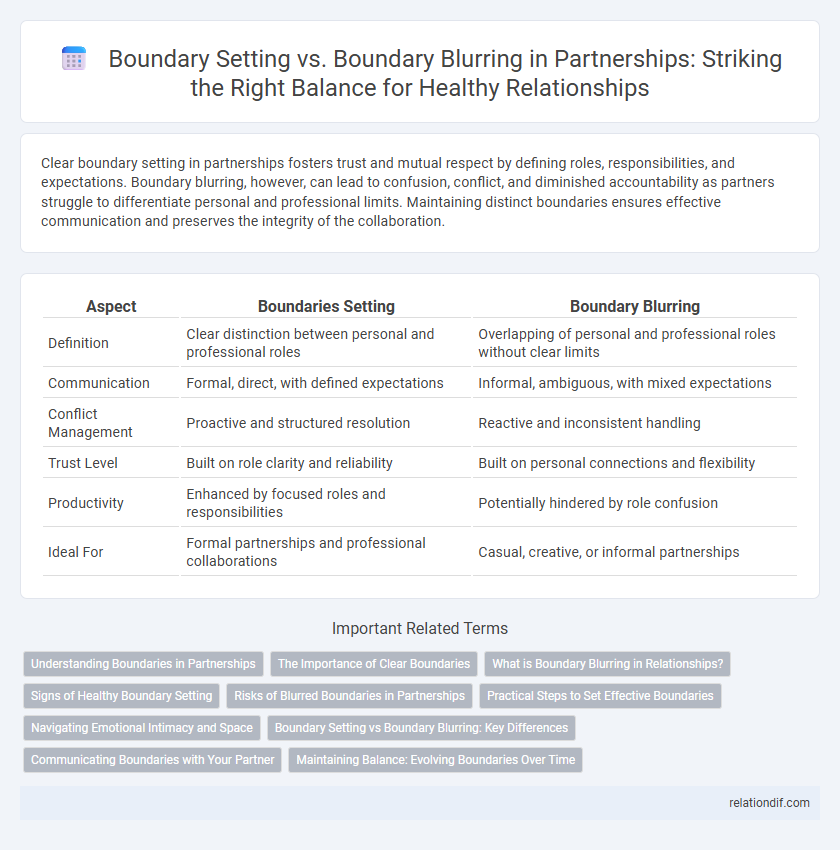Clear boundary setting in partnerships fosters trust and mutual respect by defining roles, responsibilities, and expectations. Boundary blurring, however, can lead to confusion, conflict, and diminished accountability as partners struggle to differentiate personal and professional limits. Maintaining distinct boundaries ensures effective communication and preserves the integrity of the collaboration.
Table of Comparison
| Aspect | Boundaries Setting | Boundary Blurring |
|---|---|---|
| Definition | Clear distinction between personal and professional roles | Overlapping of personal and professional roles without clear limits |
| Communication | Formal, direct, with defined expectations | Informal, ambiguous, with mixed expectations |
| Conflict Management | Proactive and structured resolution | Reactive and inconsistent handling |
| Trust Level | Built on role clarity and reliability | Built on personal connections and flexibility |
| Productivity | Enhanced by focused roles and responsibilities | Potentially hindered by role confusion |
| Ideal For | Formal partnerships and professional collaborations | Casual, creative, or informal partnerships |
Understanding Boundaries in Partnerships
Understanding boundaries in partnerships is crucial for maintaining mutual respect and trust, as clearly defined limits prevent miscommunication and conflict. Setting boundaries involves establishing expectations about roles, responsibilities, and personal space, ensuring each partner feels valued and secure. Boundary blurring, however, can lead to confusion and resentment, undermining the foundation of a healthy partnership.
The Importance of Clear Boundaries
Clear boundaries in partnerships establish mutual respect and prevent misunderstandings by defining roles, expectations, and responsibilities. Boundaries setting fosters trust and effective communication, enabling partners to collaborate without overstepping personal or professional limits. Blurring boundaries often leads to conflicts, reduced productivity, and emotional strain, highlighting the critical importance of maintaining distinct limits for healthy, sustainable partnerships.
What is Boundary Blurring in Relationships?
Boundary blurring in relationships occurs when the distinct limits between partners' individual needs, feelings, and responsibilities become unclear or intertwined. This can lead to confusion, dependence, and difficulty maintaining personal identity, often resulting in emotional strain or conflict. Maintaining clear boundaries is essential for healthy communication, mutual respect, and balanced partnership dynamics.
Signs of Healthy Boundary Setting
Signs of healthy boundary setting in partnerships include clear communication of needs and limits, mutual respect for personal space and emotional autonomy, and consistent reinforcement of agreed-upon boundaries. Partners demonstrate trust by honoring these limits without guilt or resentment, fostering an environment of psychological safety. This balance enhances relationship satisfaction and prevents boundary blurring, which can lead to confusion and conflict.
Risks of Blurred Boundaries in Partnerships
Blurred boundaries in partnerships increase the risk of miscommunication and unmet expectations, undermining trust and collaboration. Overlapping roles can lead to conflicts of interest and decision-making confusion, weakening the partnership's effectiveness. Maintaining clear boundaries preserves accountability and ensures each partner's responsibilities are respected.
Practical Steps to Set Effective Boundaries
Setting effective boundaries in partnerships involves clearly defining personal limits and consistently communicating them to maintain mutual respect and trust. Practical steps include identifying non-negotiable values, using assertive language to express needs, and regularly reassessing boundaries to adapt to changing circumstances. Avoiding boundary blurring prevents misunderstandings and power imbalances, fostering healthier and more balanced relationships.
Navigating Emotional Intimacy and Space
Effective partnership requires clear boundaries setting to maintain emotional intimacy while respecting individual space, preventing boundary blurring that can lead to confusion and emotional strain. Navigating this balance fosters trust and mutual understanding, enhancing the connection without compromising personal autonomy. Emotional boundaries enable partners to express vulnerability safely, supporting healthy intimacy and personal growth within the relationship.
Boundary Setting vs Boundary Blurring: Key Differences
Boundary setting establishes clear limits and expectations in partnerships, promoting respect and effective communication, while boundary blurring leads to confusion and potential conflict due to overlapping roles and responsibilities. Key differences include the clarity of personal and professional roles, the level of mutual respect maintained, and the ability to resolve disagreements constructively. Successful partnerships rely on intentional boundary setting to foster trust and maintain healthy collaboration.
Communicating Boundaries with Your Partner
Communicating boundaries with your partner involves clearly expressing personal limits and expectations to foster mutual respect and understanding. Establishing explicit boundaries prevents boundary blurring, which can lead to misunderstandings, resentment, and emotional strain in the relationship. Consistent, honest dialogue about individual needs supports a healthy partnership by reinforcing trust and emotional security.
Maintaining Balance: Evolving Boundaries Over Time
Maintaining balance in partnerships requires evolving boundaries over time to accommodate changing needs and circumstances. Clear boundary setting fosters mutual respect and trust, while boundary blurring may lead to confusion and conflict if not managed carefully. Adaptive boundary management promotes collaboration and resilience, ensuring both parties feel secure and valued throughout the partnership lifecycle.
Boundaries Setting vs Boundary Blurring Infographic

 relationdif.com
relationdif.com